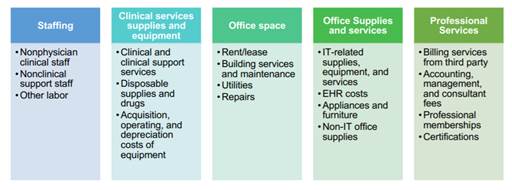Payments to physicians for the care they provide their patients should be based on the “service delivered” – not the “delivery type” – when the care meets the standard required by law.
Physicians must have the flexibility to decide whether to see their patients via telehealth or in person without unnecessary and disconnected pricing incentives.
Today, more patients have experienced the convenience of telemedicine and want to continue receiving care this way.
However, augmenting a physician practice with telemedicine incurs additional expenses different from that of delivering only in-person care.
Physician payment is determined using the “resource-based relative value scale,” which aligns payments based on the cost and resources used to provide services [1] using three factors: (1) physician work (54%), (2) practice expense (41%), and (3) medical liability (5%).
A recent RAND study lists five practice expense categories for care delivery and some components within each one. [2]

Clinical staff in the physician’s practice still have integral roles in telemedicine visits by gathering the history of present illness and other visit-related information. Plus, offering telemedicine adds these expenses:
- Telemedicine software and supporting equipment (monitors, cameras, digital exam tools),
- Staff and physician telemedicine training,
- Additional staff time assisting patients with technology challenges,
- Enhanced security,
- Remote patient monitoring tools,
- Telemedicine-specific policies and procedures,
- Supplemental telemedicine patient-education materials,
- Expanded internet bandwidth.
For continuity of care and thus better health outcomes, patients should be encouraged to seek telemedicine visits from their own physician. [3]
When physicians use their existing practice to conduct a telemedicine visit for new and established patients, they should be paid at the same contracted rate as for an in-person visit.
TMA’s Legislative Recommendation
- Ensure covered services provided to a health-plan-enrolled patient by a contracted physician are paid at the contracted rate. The service provided – whether in person or via telemedicine – should be the choice of the physician and the patient.
[1] American Medical Association. Link accessed Dec. 15, 2020. www.ama-assn.org/about/rvs-update-committee-ruc/rbrvs-overview.
[2] RAND Corporation; Practice Expense Methodology and Data Collection Research and Analysis; 2020. www.cms.gov/files/document/cy-2021-pfs-practice-expense-methodology-and-data-collection-research-and-analysis-report.pdf.
[3] Continuity of Care: Still Important in Modern-Day General Practice; 2016. www.ncbi.nlm.nih.gov/pmc/articles/PMC4979920/.
Texas Legislature main page